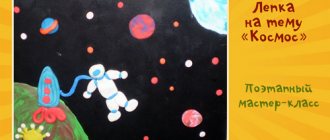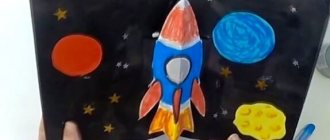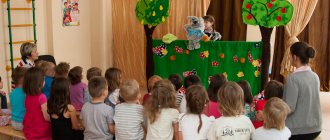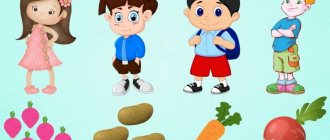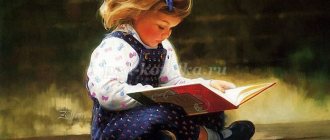Senior group. Senior preschool age. Children 5-6 years old
Abstract of GCD for designing from cardboard in a senior group on the topic “Space” Goal: Raise the emotional mood of children and make a model of a rocket from cardboard Tasks: - consolidate children’s knowledge and understanding of space ; expand children's understanding of various aircraft, their purpose (passenger, military, sports, scientific -...
Outline of educational activities with pupils of senior preschool age "Samara Cosmic"
Integration of educational areas: “Cognitive development”
,
“Speech development”
,
“Artistic and aesthetic development”
,
“Physical development”
.
Objectives: Educational area: “Cognitive development”
: to introduce preschoolers to Samara’s contribution to the development of the domestic…
MAGAZINE Preschooler.RF
Educator: Olga Valerievna Koldova, Samara, MBDOU No. 12. Target. Expand children's knowledge about space, activate cognitive interest and vocabulary on the topic "Space". Develop thinking, imagination, fantasy, creative and motor activity. Encourage children to engage in joint search activities and the ability to combine various thematic plots into a single game plot. Integration of educational areas: cognition, communication, socialization, music. Preliminary work: reading an encyclopedia about space. Conversations about the first cosmonaut, animals that have been in space, stars and planets, the Universe. Learning poetry. Materials, equipment for the lesson: demonstration material (slides about space, astronauts, children's drawings), model of the solar system. Musical accompaniment: Y. Antonov “Grass near the house”; VIA "Zodiac". Progress. Educator: Today, guys, we will continue to talk about space.Every person knows what space is. Space is the same as the Universe. This is the space that we see around our Earth, with all the celestial bodies, various particles and radiation found in it. A slender system of planets that revolves around the Sun, tailed comets, meteorites - all this is space. People have always wanted to know, is there life on other planets? And if there is, who lives there? But to find out, you need to fly to the planets. How can we fly into space now? Children: On a rocket. Educator: The wonderful scientist Konstantin Eduardovich Tsiolkovsky developed the theory of the rocket, thought through its structure and how it would move. And only many years later, another design scientist Sergei Pavlovich Korolev was able to construct a rocket and the first space satellite using Tsiolkovsky’s theories. The first dogs to fly into space were Belka and Strelka. And only after their successful landing, on April 12, 1961, a man, Yuri Alekseevich Gagarin, rose into space and became the first cosmonaut. Since then, on April 12, our country has been celebrating a holiday - Cosmonautics Day. Astronauts have a second home - in space. The space house is special. It's called an orbital station. This is where astronauts live and work. The space house looks like a huge bird that has spread its wings and flies above the earth. But wings are not needed for flight - they are a “home power plant.” Shiny plates collect the sun's rays and turn them into electric current, which powers all scientific instruments, illuminates and heats. In our city there is an Aerospace University, where scientists and students are developing new rockets. And big . The plant builds rockets and assembles engines for them. Our city, Samara, is considered the space capital of the country. Now close your eyes and imagine that you and I are going on a space journey (quiet, calm music sounds) - Can you imagine? What should astronauts be like? Now the guys will tell us. Children: Reader 1: He is an example for all the children, He is called a hero. An astronaut wears this title proudly. To become an astronaut, you have to work hard: Start the day with exercise, study well.
Reader 2: See a doctor - The exam here is strict. Star Roads are not for weaklings. Only the strong and dexterous can be taken onto the ship. And that’s why you can’t be here without training. Reader 3: Hyperbaric chamber, swimming pool, Where we are weightless... This is well known to all astronauts. Here is a carousel cabin, spinning round and round. Not a projectile, but just a beast. This centrifuge.
Reader 4: There are a lot of different tests ahead. Anyone who flies into space must pass them. He is of any profession Must know the secrets - After all, at such a height You can’t ask for advice.
Reader 5: We are only children for now, But the desired hour will come - On a space rocket Let's fly together to Mars! Educator: During flight, astronauts must follow special space rules. What are these rules? Children: 1. Astronaut, don’t forget You are on your way to the universe.
2. Our main rule is to carry out any order. 3. Do you want to become an astronaut? Must know a lot. 4. Any space route is open to those who love work. 5. Only friendly starships can take with them on a flight. 6. We will not take the boring, gloomy and angry into (orbit).
Educator: Cosmonauts must know a lot. Now we'll see how much you know. I will ask questions and you will answer them. 1. What does space mean? — The space around the Earth, with all the celestial bodies located in it. 2. What was the name of the world's first astronaut? - Yuri Alekseyevich Gagarin. 3. When does our country celebrate Cosmonautics Day? - 12th of April. 4. What is the name of the astronauts’ house? - orbital station. 5. Why is it needed? - Cosmonauts live and work there. 6. What is a space home like? - on a huge bird. 7. What is the name of the aircraft in which they fly into space? - Spaceship. 8.The fastest mode of transport created on Earth? - Rocket. 9. What is the name of the astronaut suit? - Spacesuit. 10. What is the name of both the animal and the constellation? - Ursa. 11. What were the names of the dogs who were the first to return from space? - Belka and Strelka. 12. What planets do you know? — Mercury, Venus, Earth, Mars, Jupiter, Uranus, Saturn, Neptune, Pluto. 13.The biggest and hottest star in the Universe? - Sun. 14. What is the name of the plant in Samara where rockets are assembled? - “Progress”. Educator: Well done guys, they answered all the questions. Astronauts need a special space suit - a spacesuit. It protects the human body and allows you to breathe. Let's imagine and now put on spacesuits too. Physical education (Music plays) - The astronauts have a helmet on their head (tilts and turns of the head). — The overalls should be comfortable and not hinder movement (turns and tilts of the body). — Hands are protected with gloves (rotation of hands, squeezing and unclenching of hands). — Astronaut boots with very thick soles (walking in place, jumping). — On the back behind the shoulders is a backpack with important devices and air cylinders (raising and lowering the shoulders, inhaling and exhaling) Educator: Well, we are almost ready to fly. But in order to fly into space we need a rocket. Let's collect it now. Children assemble a rocket on whatman paper from cardboard geometric shapes. They paste their photographs into the circles (portholes) (music plays). Educator: Our rocket is ready. Show what you got. What geometric shapes did you assemble it from? Children: Rectangle, circles, triangles, trapezoid. Educator: Now everything is ready for the flight. Let's start the countdown. Children: 10, 9, 8, 7, 6, 5, 4, 3, 2, 1, 0 - let's go! (music sounds and children run away).
| Next > |
“Cosmos” Summary of GCD for FCCM in the senior group
Summary of GCD in the senior group “Cosmonautics Day”
Topic: “Cosmonautics Day”
Target:
the formation of ideas about the holiday “Cosmonautics Day”, elementary ideas about space, about the first flight into space.
Tasks
1. Summarize and systematize children’s knowledge about space flights: introduce them to Russian scientists who were at the origins of the development of Russian cosmonautics-K. E. Tsialkovsky, S. P. Korolev. To consolidate children's knowledge that the first cosmonaut was Russian citizen Yuri Alekseevich Gagarin.
2.Develop memory, speech, observation, logical thinking, interest in understanding the world around us.
3. Enrich children’s vocabulary with new terms and concepts: weightlessness, gravity, satellite, etc.
4. To foster patriotic feelings, pride for our country, for the heroes of the pilots - the astronauts who conquered space.
Progress of the lesson
-Educator: Today, guys, our country celebrates Cosmonautics Day.
-Who remembers why this holiday is celebrated on April 12?
On April 12, 1961, a man flew into space for the first time in the world. It was a Russian cosmonaut.)
-What's his name? (Yuri Alekseyevich Gagarin)
Educator: Since ancient times, man dreamed of rising into the sky, and he realized his dream. This is how balloons, airplanes, and helicopters appeared. But your great-great-grandfathers could not imagine that it was possible to fly into space. And now there are people who fly there to work.
-What are they called?
Children: They are called astronauts.
—Who are astronauts? (Children's answers)
Cosmonauts are the pilots who fly spacecraft. Cosmonauts are also called crew members who conduct research on board a spacecraft.
-Why do you think man wanted to fly into space? (Children's answers)
-What helps scientists observe the starry sky? (Children's answers)
Scientists have come up with special devices - telescopes - to observe the starry sky.
-What could they see through telescopes? (Children's answers) show slides and illustrations.
They could see other planets
-What planets do you know? (Children's answers)
Moon, Mars, Venus and other planets. People really wanted to know if there was life on other planets. And if there is, who lives there? Are these living creatures similar to people? But to find out, you need to fly to these planets. Airplanes are not suitable for this, because the planets were very far away.
-And what did the scientists come up with? (Rockets, spaceships)
-Who was the first in Russia to come up with a rocket? (Konstantin Eduardovich Tsialkovsky) portrait showing.
A simple teacher, Konstantin Eduardovich Tsialkovsky, lived in the city of Kaluga. He loved to watch the stars through a telescope, studied them, and he really wanted to fly to these planets. And he decided to design an aircraft that could fly to some planet. He made drawings, carried out calculations and came up with such an aircraft. But, unfortunately, he did not have the opportunity to make such an aircraft.)
-Who made such an aircraft anyway? (Children's answers - Sergei Pavlovich Korolev (portrait showing) - a design scientist who, after many, many years, was able to design and manufacture the first space satellite. The first two dogs to fly into space and back on a rocket were Belka and Strelka. But they could not tell about his journey, and a man went into space.)
-The first flight into space was made by our cosmonaut, Yuri Alekseevich Gagarin. An ordinary Russian guy. We are proud that OUR Russian was the first to fly into space. (Slide show). Before enlisting in the cosmonaut corps, he served as a fighter pilot in the aviation regiment of the Northern Fleet. What do you think Gagarin had to do to become an astronaut?
Children: play a lot of sports.
Educator: That's right guys, in order to become an astronaut, Yuri Gagarin had to do exercises. But not morning exercises, as we do in kindergarten, he swam and ran for several kilometers in a special suit with weights. I swam for several hours in a diver's suit and spun in a centrifuge. Who knows what a centrifuge is and who tolerates it better?
Children: a test apparatus for astronauts, but a person who does not feel dizzy can be in it.
Educator: That's right guys, this is a testing apparatus. Thanks to this device, doctors determine whether an astronaut will be able to fly into space and whether he will withstand the stress of weightlessness. And people who rode on swings as children and did not feel dizzy can be in a centrifuge. (Show the centrifuge on the slide). First of all, astronauts must have good health. After all, no other profession has more difficult working conditions than astronauts. During take-off and landing, astronauts experience severe overloads.
-What is overload? (Children's guess)
Overload is when the body is faced with loads that not everyone can withstand. For example, when a rocket takes off and when it lands, the body of the person in the spaceship becomes very heavy, and the arms and legs cannot be lifted. But when the spaceship is in space, the body becomes light as feathers and people fly around the ship like feathers.
-What is this state called in space? (State of weightlessness.)
Phys. just a minute:
1. Zero gravity on the stomach - guys, now we lie down on chairs with our stomachs and raise our legs and arms. Repeat after me, we lift and fly. Next exercise:
2. Flight in zero gravity on your back - guys lie on your back and raise your legs and arms up. We move them left and right at the same time. Let's imagine, guys, that we are in outer space and making a flight. Next exercise:
3. Magnetic boots: and now the guys get up from their chairs and put on the astronaut boots. Astronauts' boots are very heavy, so take your time and repeat after me. Raise your right leg and lower it. We raise our left leg and lower it. Now let's take 2 steps forward, one, two. Well done, now take 2 steps back, one, two. What heavy boots? Did you all manage?
Children: yes, that's it!
Educator: Well done, the astronauts prepared for the flight. Do you know what astronauts fly on?
Children: on space rockets!
Yuri Gagarin flew into space on a rocket.
A simple example can illustrate the principle of rocket flight. You need to inflate the balloon and pinch the hole with your fingers. And then unclench your fingers and our ball will suddenly burst upward. This happens because air escapes from the balloon. And when the air runs out, the ball will fall. Our ball flew like a rocket - it moved forward as long as there was air in it.
This is roughly the same principle that a rocket flies into space. Only instead of air it has fuel. When burning, the fuel turns into gas and bursts back into flame.
A rocket is made of several parts called stages, and each stage has its own fuel tank.
The first stage runs out of fuel - it falls away, and the second stage engine immediately turns on and carries the rocket even faster and even higher. So only the third stage – the smallest and lightest – reaches space. It launches the cabin with the astronaut into orbit. After Yuri Gagarin, hundreds of cosmonauts flew into space.
Educator: Who knows what the astronauts' food is in?
Children: astronaut food comes in tubes!
Educator: That’s right, the astronauts’ food is in tubes, otherwise the astronauts would be chasing around the ship, either for bread or for juice, in a state of weightlessness.
Educator: who knows the name of the astronaut’s special protective suit and his headdress?
Children: the costume is called a spacesuit, and the headdress is a helmet.
Educator: spacesuit and helmet are correct.
-What are they for?
Children: to go into space.
Educator: correct in order to safely go into space. What is a helmet used for in space?
Children: so that the astronaut can breathe.
Educator: It is correct that an astronaut in outer space can breathe. And there are two types of spacesuits: in one the astronaut goes into outer space - it is white. And in the second he is in a spaceship.
Educator: Guys, do you know what the window in the rocket is called?
Children: the window in a rocket is called a porthole!
Educator: That's right, guys, porthole, let's repeat it all together - porthole. If you and I look out the window, what can we see?
Children: planets, moon, comets, satellites, sun.
Educator: Who can tell me what it is called, the only satellite of planet Earth).
Children: the satellite of our planet Earth is called the Moon!
Educator: correct - Moon. And on the Moon the force of gravity is very weak. Therefore, you and I will flutter on it like feathers. The same ease of flight will be on Pluto. And Jupiter has the greatest gravity.
Educator: When flights into space began, we had to think about where the astronauts should live, so as not to spend too much time on the road to their place of work.
First, our scientists built the MIR space station, and then it was replaced by the more modern International Space Station (ISS). Astronauts from different countries live and work on it (engaged in space exploration) for a long time.
And in 1965, Alexey Leonov first stepped out of a rocket into outer space. Dressed in a spacesuit, he hung next to the ship in empty space for several minutes.
Everyone knows who a robot is. So, robots often work in space. Such robots help people explore planets. For example, robots were able to take a handful of soil from the Moon and bring it to Earth for research.
Robotic machines have visited Venus, penetrating its toxic clouds, and now scientists have maps of the planet.
Soon, robotic lunar rovers were launched to the Moon, traveling on the surface of the Moon and transmitting data to Earth.
And now hundreds of robotic satellites are flying around our Earth. They transmit weather information to the ground and monitor the movement of ships in the ocean.
There are nine planets in our solar system, which are arranged in this order: Mercury, Venus, Earth, Mars, Jupiter, Saturn, Uranus, Neptune, Pluto.
- Maybe one of you will also become an astronaut or a rocket designer and invent a rocket in which people will not experience such overloads as cosmonauts are experiencing now, and will glorify our Motherland.
So our lesson journey has ended. A wish for the children. To become an astronaut you need to study hard and play sports every day. Astronauts are hired to be diligent people who are not lazy and work hard!
